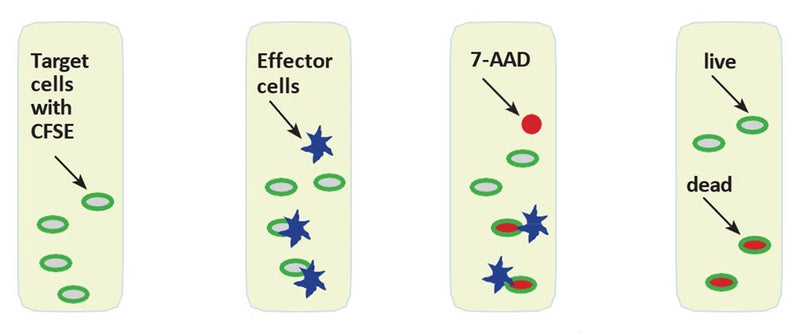Cytolytic activity is an important process for eliminating intracellular pathogens and cancer cells. This process is accomplished through various immune effector mechanisms including natural killer (NK) leukocytes. NK activity is facilitated by non-specifically lysing infected targets through the use of NK receptors, or the FcγII (CD16) receptor, recognizing IgG bound to specific antigens on the target cell surface. NK cells may also induce apoptosis in target cells. The activity of natural killer cells, and their effect on target cells, is frequently studied in immunomodulation experiments.
Older methods to assess NK cytolytic activity include measuring the release of lactate dehydrogenase, and more commonly, the release of radioactive 51Cr from lysed target cells. Unfortunately, these techniques have several drawbacks. Traditional enzyme-release assays are often skewed by the large number of necrotic effector cells. Problems associated with 51Cr release methods include high spontaneous leakage resulting in high backgrounds, high cost, short half-life, and the health risks due to exposure to radioactive material.
Flow cytometric assays have been developed to overcome some of the difficulties associated with older assays like lactate dehydrogenase and 51Cr release assays. One such early version involved the detection of NK cytotoxicity activity by staining target cells with the green fluorescent dye, F-18, in combination with the DNA intercalating dye, propidium iodide. Since then, a red fluorescent membrane dye, PKH-26, has been used in preference to F-18, and in combination with the viability probe, TO-PRO-3 iodide. However, despite correlations of greater than 95% when com- pared with the 51Cr release assay, the PKH-26 method is problematic. It is difficult to use at a constant concentration, leading to unreliable staining, and the staining procedure requires multiple steps, often decreasing the viability of the target cells.
More recently, the problems with older flow cytometric assays were overcome with the use of 5(6)-carboxyfluorescein diacetate N-succinimidyl ester (CFSE), a green fluorogenic reagent that diffuses into target cells and covalently binds to primary amino groups on intracellular molecules. Intracellular esterases quickly cleave the acetate groups from the dye, thus converting it to its green fluorescent form. Any unbound reagent diffuses back out of the cell. Building upon these techniques, ImmunoChemistry Technologies has developed the Basic Cytotoxicity Assay, a flow cytometry assay combining the green fluorescing cellular stain, (CFSE), with a red fluorescing live/dead stain, 7-aminoactinomycin D (7-AAD). The assay can be used to quantify cytolytic killer activity and distinguish target and effector cells, and live and dead cells within a single sample tube.
In the Basic Cytotoxicity Assay, CFSE is first used to label the target cell population green (Figure 4). The unstained effector cells are then added and incubated with the target cells (referred to as the Effector:Target, or ‘E:T’ mixture, Figure 5). As all of the target cells are initially labeled with green fluorescing CFSE, and the effector cells are not, these two populations can easily be differentiated (Figure 7). Upon completion of the E:T incubation, the second reagent, 7-AAD, is added to stain all necrotic cells red by binding to the DNA of membrane-compromised cells (Figure 6). With proper compensation and gating of the flow cytometer using the designated instrument controls (Figures 3 and 7-10), researchers can distinguish between target and effector cells, and living and necrotic cells, and assess the level of cytotoxicity in their samples (Figure 10).














